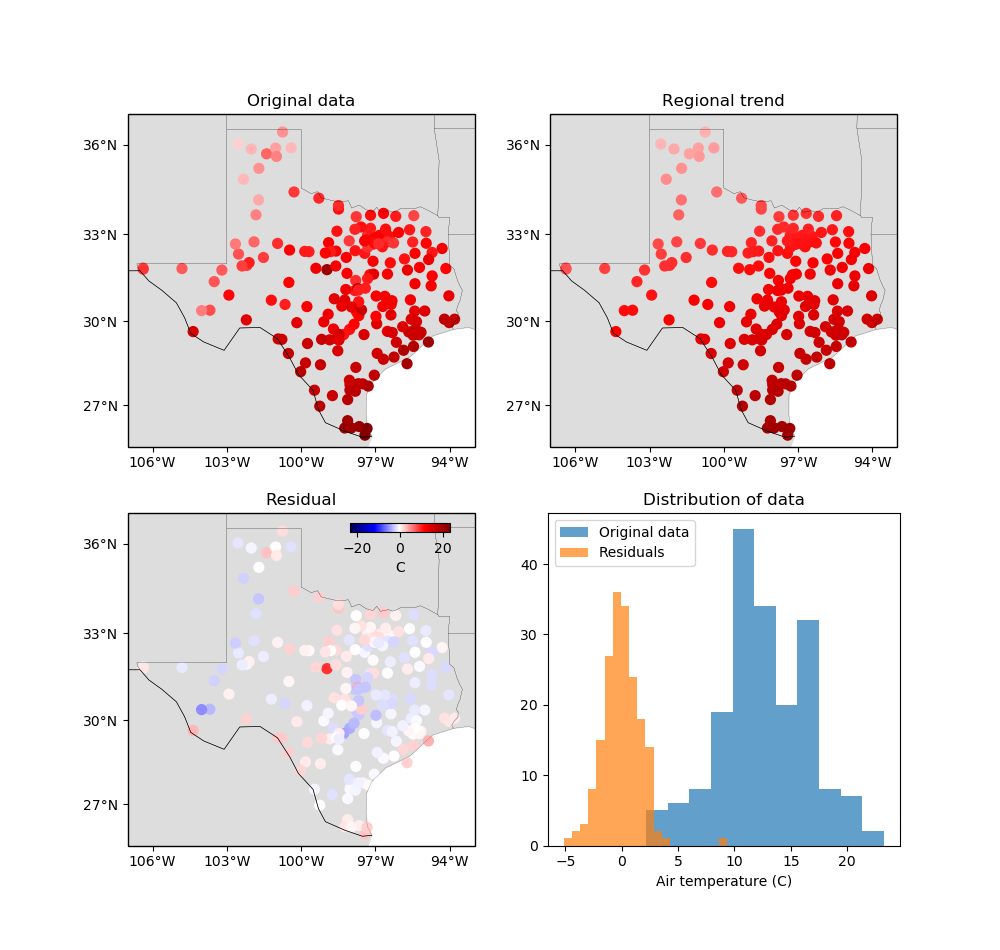Note
Click here to download the full example code
Polynomial trend¶
Verde offers the verde.Trend class to fit a 2D polynomial trend to your data.
This can be useful for isolating a regional component of your data, for example, which
is a common operation for gravity and magnetic data. Let’s look at how we can use Verde
to remove the clear trend from our Texas temperature dataset
(verde.datasets.fetch_texas_wind).

Out:
Original data:
station_id longitude ... wind_speed_east_knots wind_speed_north_knots
0 0F2 -97.7756 ... 1.032920 -2.357185
1 11R -96.3742 ... 1.692155 2.982564
2 2F5 -101.9018 ... -1.110056 -0.311412
3 3T5 -96.9500 ... 1.695097 3.018448
4 5C1 -98.6946 ... 1.271400 1.090743
[5 rows x 6 columns]
Trend estimator: Trend(degree=1)
Updated DataFrame:
station_id longitude latitude ... wind_speed_north_knots trend residual
0 0F2 -97.7756 33.6017 ... -2.357185 9.067526 0.168585
1 11R -96.3742 30.2189 ... 2.982564 14.727121 -0.512816
2 2F5 -101.9018 32.7479 ... -0.311412 8.508071 -1.438626
3 3T5 -96.9500 29.9100 ... 3.018448 14.931638 -0.434877
4 5C1 -98.6946 29.7239 ... 1.090743 14.434636 -1.476303
[5 rows x 8 columns]
/home/travis/build/fatiando/verde/examples/trend.py:78: UserWarning: This figure includes Axes that are not compatible with tight_layout, so results might be incorrect.
plt.tight_layout()
/home/travis/build/fatiando/verde/examples/trend.py:78: UserWarning: Tight layout not applied. The left and right margins cannot be made large enough to accommodate all axes decorations.
plt.tight_layout()
import numpy as np
import matplotlib.pyplot as plt
import cartopy.crs as ccrs
import verde as vd
# Load the Texas wind and temperature data as a pandas.DataFrame
data = vd.datasets.fetch_texas_wind()
print("Original data:")
print(data.head())
# Fit a 1st degree 2D polynomial to the data
coordinates = (data.longitude, data.latitude)
trend = vd.Trend(degree=1).fit(coordinates, data.air_temperature_c)
print("\nTrend estimator:", trend)
# Add the estimated trend and the residual data to the DataFrame
data["trend"] = trend.predict(coordinates)
data["residual"] = data.air_temperature_c - data.trend
print("\nUpdated DataFrame:")
print(data.head())
# Make a function to plot the data using the same colorbar
def plot_data(column, i, title):
"Plot the column from the DataFrame in the ith subplot"
crs = ccrs.PlateCarree()
ax = plt.subplot(2, 2, i, projection=ccrs.Mercator())
ax.set_title(title)
# Set vmin and vmax to the extremes of the original data
maxabs = vd.maxabs(data.air_temperature_c)
mappable = ax.scatter(
data.longitude,
data.latitude,
c=data[column],
s=50,
cmap="seismic",
vmin=-maxabs,
vmax=maxabs,
transform=crs,
)
# Set the proper ticks for a Cartopy map
vd.datasets.setup_texas_wind_map(ax)
return mappable
plt.figure(figsize=(10, 9.5))
# Plot the data fields and capture the mappable returned by scatter to use for
# the colorbar
mappable = plot_data("air_temperature_c", 1, "Original data")
plot_data("trend", 2, "Regional trend")
plot_data("residual", 3, "Residual")
# Make histograms of the data and the residuals to show that the trend was
# removed
ax = plt.subplot(2, 2, 4)
ax.set_title("Distribution of data")
ax.hist(data.air_temperature_c, bins="auto", alpha=0.7, label="Original data")
ax.hist(data.residual, bins="auto", alpha=0.7, label="Residuals")
ax.legend()
ax.set_xlabel("Air temperature (C)")
# Add a single colorbar on top of the histogram plot where there is some space
cax = plt.axes((0.35, 0.44, 0.10, 0.01))
cb = plt.colorbar(mappable, cax=cax, orientation="horizontal",)
cb.set_label("C")
plt.tight_layout()
plt.show()
Total running time of the script: ( 0 minutes 0.422 seconds)